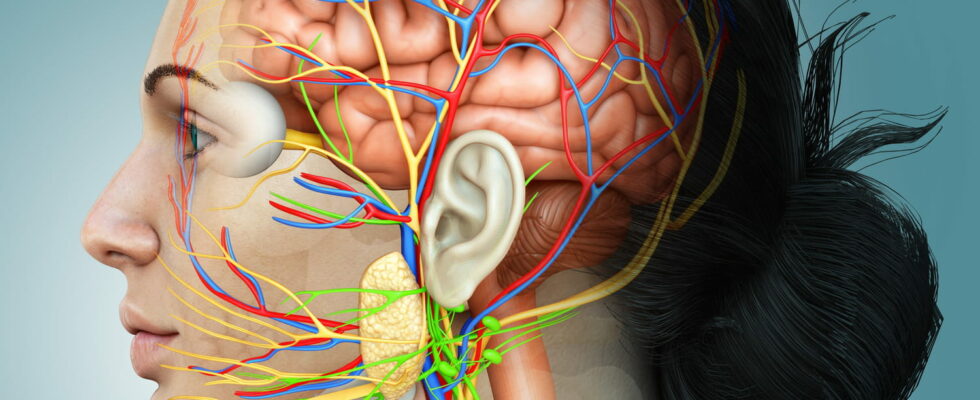Spinal cord cancers or tumors are fairly rare brain cancers. Reference treatment, surgery often allows a cure. Symptoms, age, cause, life expectancy: discovery.
THE spinal cord cancers or tumors are brain cancers which are rare. They grow inside the parenchyma of the spinal cord (cancer is said to be intramedullary) or outside the parenchyma (the cancer is said to be extramedullary). According figures from the Brain Institute, 240,000 people in Europe have brain cancer. What are the spinal cord cancer symptoms ? Is it a curable cancer? How is it diagnosed?
What is spinal cord cancer?
“Spinal cord tumors affect the central nervous system. These tumors are quite rare. They represent less than 10% of spinal tumors. Bone tumors are more commondefines Pr Cédric Barrey, head of the neurosurgery department – spine and spinal cord surgery at the Lyon University Hospital. These tumours, which are most often benign, are nevertheless worrying because they can have major consequences: risk of paralysis, sensory disturbances in the limbs and/or urinary disorders“.”In terms of epidemiology, bone marrow tumors represent around a hundred operations in France each year and around one to two thousand for schwannomas and meningiomas.” indicates the specialist. These tumors can affect the cervical or dorsal spinal cord.
What are the symptoms of spinal cord cancer?
“Symptoms of spinal cord tumors are mostly neurological because they cause compression or pain in the spinal cord“says Professor Barrey. It may be neurological deficits on the motor side :
- leg weakness,
- fatigue when walking,
- motor difficulties in the upper limbs to perform fine gestures such as writing.
These signs are quite discreet at first and then paralysis sets in gradually over time with, at the end of the evolution, a severe motor deficit at the level of the 4 limbs.
It can also be signs on the sensory side :
- intermittent then permanent tingling of the limbs,
- loss of sensitivity to touch in the hands and feet,
- walking difficulties
Finally, there may be signs on the sphincter side“:
- urinary leakage,
- difficulty urinating,
- constipation
What are the causes of spinal cord cancer?
► There are intramedullary tumors located directly in the spinal cord, mainly represented by gliomas (ependymomas in two thirds of cases and astrocytomas in one third of cases)
► And the intradural tumors and therefore extramedullary, represented essentially schwannomas (formerly called neuromas) and meningiomaswhich sit in one of the membranes which envelop the marrow, which is called the dura mater and which compresses this marrow.
► There are also tumors located outside the dura mater, called extradural tumorsessentially represented by vertebral metastases and can lead to spinal cord compression.
Is it serious cancer?
Among all these tumours, some are benign like schwannomas and meningiomas, but others are potentially malignant like gliomas, or directly malignant like metastases, resulting from the migration of cancer cells from another organ.
What is the life expectancy of spinal cord cancer?
“Surgery is effective and most often allows complete excision of the tumor with healing, but there are, however, a risk of recurrence in 5 to 10% of cases after an intervention of this type, sometimes requiring a new operation” emphasizes Professor Barrey. Monitoring by MRI is systematically put in place after the operation, once a year at the beginning then every two or three years.
What is the average age of onset of spinal cord cancer?
The risk exists at any age but spinal cord tumors are more common after 60 years.
Faced with this type of neurological symptom, a consultation is necessary and imaging is done quickly. “The reference examination consists of an MRI of the spinal cord (spinal MRI) with injection of product. MRI makes it possible to make the diagnosis, to clearly specify the characteristics of the tumor, to have arguments in favor of the type of tumor and to see the state of the marrow.“explains Professor Cédric Barrey.
What treatment to cure spinal cord cancer?
“The treatment of spinal cord tumors is surgical” informs Professor Cédric Barrey. It consists of complete resection of the tumor. “It’s a delicate treatment that is done in micro-surgery, under an operating microscope and in a reference centre. This intervention, which is long, is done in collaboration with a neurologist who monitors the functioning of the spinal cord during the operation.” he describes. If the tumor is a metastasis, the cancer at the origin of this metastasis must also be treated specifically. “If there are sequelae, rehabilitation is implemented after surgery“Informs Professor Barrey.
Can spinal cord cancer be completely cured?
“Since the majority of spinal cord tumors are benign, when the tumor is completely removed, the patient is cured, reassures Professor Cédric Barrey. And most often there is little or no neurological sequelae“. It is very important that this surgery is done in a department that specializes in spinal cord surgery.
Thanks to Professor Cédric Barrey, head of the neurosurgery department – spine and spinal cord surgery at the CHU de Lyon.
